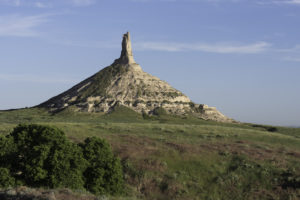
This month, we take a journey out west to Nebraska, where early settlers roamed the state. It used to be nicknamed the “Tree Planter’s State,” but was changed in 1945 to the “Cornhusker State.” Husking corn was done by hand by early settlers of course (before the invention of husking machinery). The University of Nebraska athletic team is called the Cornhuskers.
Nebraska is a Midwestern U.S. State encompassing the prairies of the Great Plains, the towering dunes of the Sandhills and the panhandle’s dramatic rock formations. Lincoln, the capital and a vibrant university town, is distinguished by its soaring state capitol. The city of Omaha is home to the Durham Museum, which honors the state’s pioneering past in a converted railroad depot.
Two major climatic zones are represented in the state: the eastern half of the state has a humid continental climate and the western half, a semi-arid climate. The entire state experiences wide seasonal variations in temperatures and precipitation. Temperatures vary across Nebraska, with hot summers and generally cold winters. The Chinook Winds from the Rocky Mountains provide a temporary moderating effect on temperatures in western Nebraska during the winter months.
Nebraska lies in Tornado Alley. Thunderstorms are common in the spring and summer months, and violent thunderstorms and tornadoes happen primarily during the spring and summer, though they can also occur in the autumn.
Nebraska is the only triply landlocked state. This means to reach an ocean, gulf, or bay from Nebraska, one must always travel south through at least 3 states: Kansas, Oklahoma, and Texas to the Gulf of Mexico; north through South Dakota, North Dakota and Manitoba to the Hudson Bay; east through Missouri, Kentucky, and Virginia to the Atlantic Ocean; or west through Wyoming, Idaho, and Oregon to the Pacific Ocean.
Business Climate
Nebraska has a large agricultural sector, and is a major producer of beef, pork, corn (miaze) soybeans, and sorghum. Other important economic sectors include freight transport (by rail and truck), manufacturing, telecommunications, information technology, and insurance.
Omaha is home to Berkshire Hathaway, whose chief executive officer (CEO), Warren Buffet, was ranked in March 2009 by Forbes Magazine as the second richest person in the world. The city is also home to Mutual of Omaha, InfoUSA, TD Ameritrade, West Corporation, Valmont industries, Woodmen of the World, Kiewit Corporation, Union Pacific Railroad, and Gallup.
The Union Pacific Railroad, headquartered in Omaha, was incorporated on July 1, 1862, in the wake of the Pacific Railway Act of 1862. Bailey Yard, in North Platte, is the largest railroad classification yard in the world. The route of the original transcontinental railroad runs through the state.
Lincoln’s Kawasaki Motors Manufacturing is the only Kawasaki plant in the world that produces the Jet Ski, All-terrain vehicle (ATV), and Mule lines of product. The Spade Ranch, in the Sandhills, is one of Nebraska’s oldest and largest beef cattle operations.
Tax Climate
Nebraska has a progressive income tax. The state has 4 tax brackets and has a top individual rate of 6.84%. The state has a top corporate income tax rate of 7.81%.
Nebraska has a state sales and use tax of 5.5%. In addition to the state tax, some Nebraska cities assess a city sales and use tax, in 0.5% increments, up to a maximum of 1.5%. Food and ingredients that are generally for home preparation and consumption are not taxable. However, all tangible personal property within the state is taxable unless specifically exempted by statute.
Other taxes that are of interest to consumers are the gasoline tax and cigarette tax. The state levies a gasoline tax of 28.2 cents per gallon, which ranks 19th in the nation, and a state cigarette rate of $0.64 per 20-pack, which ranks 40th in the country.
For our technology clients, Nebraska is all over the board in its approach to taxation of technology products for sales tax purposes. All digital books, digital audio works and digital audio visual works are subject to taxation. However, digital magazines and digital newspapers are exempt from taxation. Prewritten and custom software is taxable. Software-as-a-Service is exempt from taxation, as are all cloud services. How products are produced, sold and delivered is critical to determining its tax status.
Tax Incentives and Credits
Businesses in Nebraska, and those considering moving to Nebraska, may be able to take advantage of several tax credits. Some of these include:
Nebraska Advantage Research and Development Act- The Nebraska Advantage Research and Development Act created a research tax credit, which is available for tax years beginning on or after January 1, 2006. A business firm that incurs research and experimental expenditures in Nebraska is eligible for the tax credit. For more information on this Act, click here.
Nebraska Historic Tax Credit (Nebraska Job Creation and Mainstreet Revitalization Act- The Nebraska Job Creation and Mainstreet Revitalization Act is jointly administered by the Nebraska State Historical Society (NSHS) and the Nebraska Department of Revenue. The Act provides $15 million in Nebraska Historic Tax Credits (NHTCs) to be allocated annually beginning January 1, 2015 and ending December 31, 2022. The credit is equal to 20% of eligible expenditures incurred for improvements to qualifying historically significant real property and is limited to a $1 million tax credit per project. For more information on this program, click here.
Our team at Miles Consulting Group is always available to discuss the specifics of your state tax situation, whether in Nebraska or other states, we can help you navigate the complex tax structures arising from your multistate operations. Call us to help you achieve the best tax efficiencies.
Random Facts
- Kool-Aid was created in 1927 by Edwin Perkins in the city of Hastings, which celebrates the event the second weekend of every August with Kool-Aid days and Kool-Aid is the official soft drink of Nebraska.
- CliffsNotes were developed by Clifton Hughes of Rising City.
- Nebraska’s Chimney Rock was the most often mentioned landmark in journal entries by travelers on the Oregon Trail.
- The Naval Ammunition Depot located in Hastings was the largest U.S. ammunition plant providing 40% of WWII’s ammunition.
- The University of Nebraska Cornhusker football team has produced more Academic All-Americans than any other Division I school.
- A unique car sculpture, called Carhenge, which replicates the large stone structure in Stonehenge, England exists in Alliance, Nebraska off of highway 59.



















